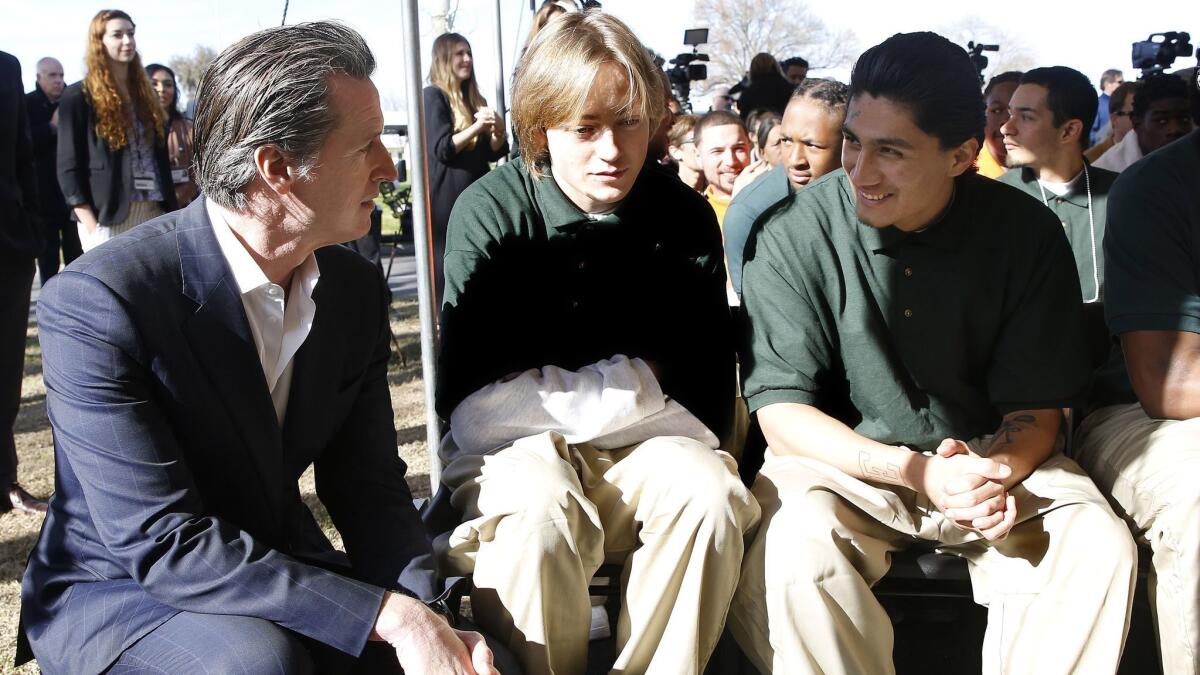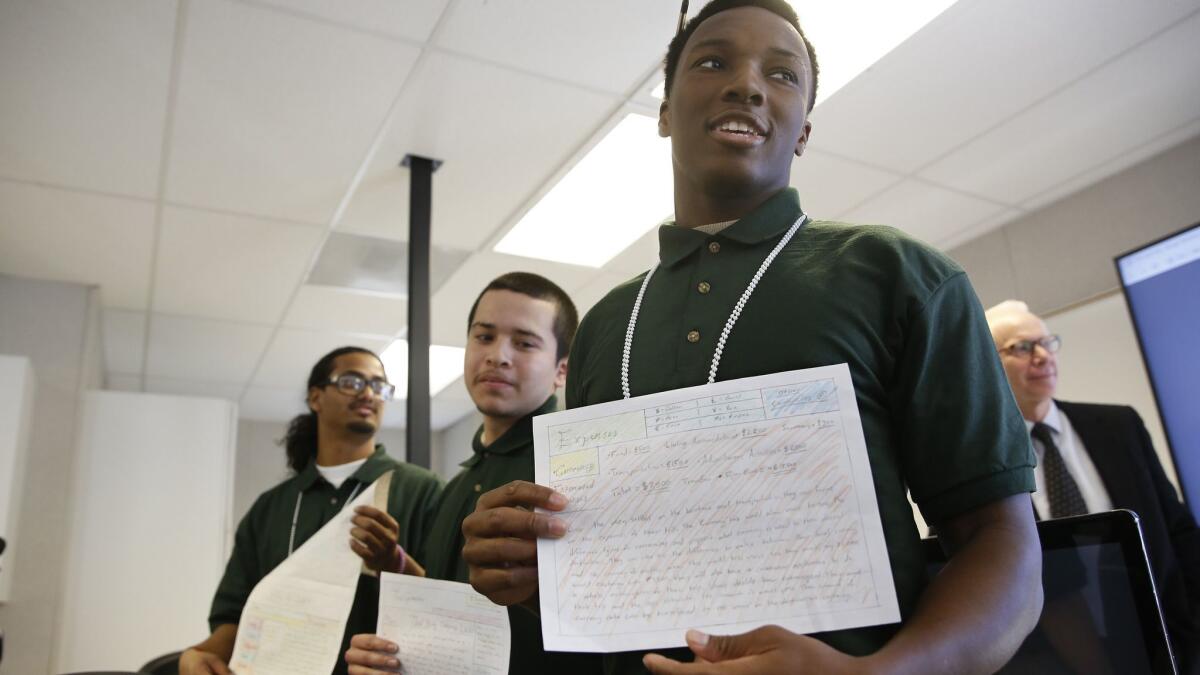Newsom plans to move California Juvenile Justice Division out of corrections department

- Share via
Reporting from Stockton — California Gov. Gavin Newsom said Tuesday that he intends to shift control of the state’s Juvenile Justice Division away from corrections officials to government health and human services providers, a move he called long overdue and necessary to build on past efforts to divert children and teens from a path to prison.
Under the proposal, first unveiled as part of his January budget, the California Health and Human Services Agency would oversee more than 660 young offenders, the majority held at a camp in Pine Grove and three detention centers in Stockton and Camarillo. It is a small population compared with the more than 39,000 young people on probation or detained in juvenile halls statewide and the hardest to serve because of the serious charges and mental and medical health needs they face.
Corrections and health and human services officials say the plan heralds a cultural change in the state’s approach to the youngest in the justice system, and creates opportunities to better bridge educational, mental health and social services to prepare minors for release.
But probation officers, healthcare professionals and community activists who have long been at the forefront of a push to shut down youth detention centers and improve treatment are wary that the changes could merely be symbolic — or worse, halt progress that they say has led to fewer young people in custody.
Touring one of the facilities in Stockton on Tuesday, Newsom sought to assuage concerns and said he hopes to initiate the transfer as early as July with approval from the Legislature.
He pointed to pre-apprentice construction labor programs and new computer coding classes as the kind of initiatives that allow young inmates to learn work and life skills behind bars and would be expanded under the new health and human services framework.
“This is about setting a new mark,” he told an audience of elected officials, reporters and young inmates. “We are committed about ending the juvenile justice system as we know it once and for all.”
California’s first-ever surgeon general, Dr. Nadine Burke Harris, who was appointed on Monday, said the new model would allow health officials to move toward one focused on addressing early childhood trauma and preventing children from falling into incarceration in the first place.
“Really looking at what we can do for our young folks who are most vulnerable is really critical,” said Burke Harris, who plans to begin her term with a listening tour across the state to hear residents’ healthcare concerns.
California is one of only 10 states that houses its juvenile justice division under a state corrections agency. Roughly 40 states have placed juvenile detention under health and human services or child welfare departments. Another 17, including Texas, Florida and Washington, D.C., have made their divisions independent entities.
California’s juvenile justice system has seen a dramatic transformation over the last 15 years. Bipartisan efforts by Republican Gov. Arnold Schwarzenegger and state lawmakers in 2005 reshuffled the embattled California Youth Authority, which at its peak housed 10,000 juveniles, after a decade of criticism and lawsuits over 23-hour lockdowns, beatings by staff and the caging of children.
Emphasis was placed on rehabilitation, eight of 11 once-overcrowded youth facilities were ultimately closed and control of youth detention was shifted to county probation departments under a realignment plan passed by the Legislature in 2007 that became the blueprint for Gov. Jerry Brown to reorganize the adult prison system years later.
Roughly 90% of young people in detention are now on probation or confined to county juvenile halls closer to their homes and families. The state’s Juvenile Justice Division, under the $12-billion California Department of Corrections and Rehabilitation, detains only teens and young adults with the most serious charges and the greatest needs, a population of mostly African American and Latino teens ages 17 and 18.
Many questions remain about how Newsom’s proposal will be implemented and what effect it will have on day-to-day operations, including the role of corrections-trained youth counselors and pay and work benefits for officers already inside the detention facilities.
Unlike adults in prison, young inmates released from corrections facilities are not paroled but returned to local probation departments. It’s unclear what the new release process would look like.
“The devil is going to be in the details,” said Dominique Nong, senior policy associate at the California branch of the child advocacy nonprofit Children’s Defense Fund. “When you change the home of the [Juvenile Justice Division], it doesn’t necessarily change the practices, but it does create opportunities to change them.”
Probation chiefs said they are concerned about how Newsom’s proposal could affect strides made in the last decade to ensure that rehabilitative programs for released youth are based on accountability and research.
“It is very easy to just say that you are working to implement evidence-based practices, but [the Department of Juvenile Justice] has actually worked with experts to bring in a lot of programs that are very similar to what we’re offering,” said Stephanie James, president of the Chief Probation Officers of California, which lobbies for the interests of the state’s probation chiefs. “We just want to make sure we are not going backwards.”
Many working in the juvenile justice system say they are on the alert because they remember the decline of the California Youth Authority and the rise of punitive measures toward the most vulnerable in the system. Soaring crime in the 1980s and ’90s fueled a tough-on-crime approach that included the expansion of longer sentences, the transfer of young people into the adult system and the adoption of life-without-parole sentences for juvenile offenders.
Researchers at the time believed teens’ brains were fully developed, and public attention tended to focus on so-called “superpredators,” youths believed to be prone to violent crime because of how they were raised. The studies have since been debunked; new research has shown that adolescent brains have not fully matured and that aggressive policing and court fees have disproportionately affected low-income and black and Latino children.
California voters have largely agreed, helping spur a shift in how young defendants are treated in the justice system. Proposition 57, a 2016 law that overhauled the state parole system, prohibits prosecutors from charging youths in adult court without a judge’s approval. The California Supreme Court, affirming a lower court ruling, found that provision could retroactively apply to pending cases.
Over the last two years, Brown also signed legislation to increase parole opportunities and ease punishment for young people facing charges and serving time, a victory for a statewide coalition of criminal justice groups that brought together celebrities and former youth offenders in a push to divert children from prison.

But some worry neuroscience studies that are still being reviewed could push the pendulum too far in the opposite direction, and that the governor is overhauling the system without taking into consideration a nationwide drop in juvenile crime. In California, the number of arrests statewide has declined since 1980, “driven primarily by plummeting arrest rates for juveniles and young adults,” according to the Public Policy Institute of California.
“We need to understand the trends as they are now before we go on in proposing what to do with the juvenile justice system,” said Mike Males, a senior researcher for the Center on Juvenile and Criminal Justice in San Francisco.
At the O.H. Close Youth Correctional Facility on Tuesday, Newsom pledged to “think systematically and thoughtfully” to counter what he called an “institutional apathy toward change” as he visited students in the facility’s Code.7370 class. In that program, instructors from Google, Facebook and other Silicon Valley companies teach students to build websites and design their own apps.
Among those who greeted the governor was Derrick McDougal, 19, of San Francisco, who has been incarcerated over the last year on charges of attempted murder. As he worked with classmates to build a travel website, he said he wanted to put his criminal days behind him.
“I want to really start building my own future,” he said.
More stories from Jazmine Ulloa »
Follow @jazmineulloa on Twitter, sign up for our daily Essential Politics newsletter and listen to the weekly California Politics Podcast
More to Read
Get the L.A. Times Politics newsletter
Deeply reported insights into legislation, politics and policy from Sacramento, Washington and beyond. In your inbox three times per week.
You may occasionally receive promotional content from the Los Angeles Times.











